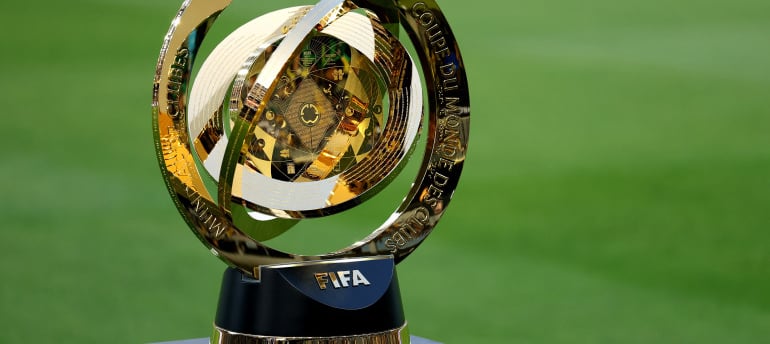Club World Cup 2025: quarter-final line-ups and times
After the Round of 16, four quarter-finals are scheduled in the USA: PSG-Bayern (July 5 at 6pm), Palmeiras-Chelsea (July 5 at 3am), Inter Milan/Fluminense versus Manchester City/Al-Hilal (July 4 at 9pm) and Real Madrid/Juventus versus Dortmund/Monterrey (July 5 at 10pm). PSG, following their 4-0 win over Inter Miami, will face the great Bayern Munich.
FOOTBALL
By Emmanuel Louis
6/30/20257 min read


Introduction to the Club World Cup
The FIFA Club World Cup represents a pinnacle of international club football, showcasing elite teams from various continents vying for global supremacy. Established in 2000, the tournament was designed to replace the Intercontinental Cup and has evolved significantly over the years. Its inaugural edition gathered the world's best clubs but faced challenges in its formative years, resulting in a more structured framework by the mid-2000s which gained traction among football fans and players alike.
Traditionally held annually, the Club World Cup features champions from the six continental confederations alongside the host nation's top team. This format highlights the diversity and competitive nature of the global football landscape, providing fans with thrilling matches that encapsulate the passion of football from different cultures. Historically, teams like Real Madrid and Barcelona from Europe, along with clubs such as Al Ahly from Africa and Atlético Mineiro from South America, have delivered memorable performances that etched their names into the tournament's storied history.
The competition serves not only as a platform for showcasing regional champions but also as an opportunity for clubs to enhance their global presence and prestige. As the tournament has progressed, it has become increasingly significant in the football calendar, attracting viewership from millions worldwide. The Club World Cup allows lesser-known teams to shine on a global stage, which is crucial for the growth and popularity of football in various regions. Furthermore, with the advent of modern technology, matches are more accessible than ever to audiences around the globe, heightening the excitement surrounding the competition.
This upcoming edition promises to continue the tradition of thrilling matchups while drawing attention to the evolution of international club competitions. As we delve deeper into the quarter-final draw, the importance of the Club World Cup in today’s football landscape cannot be overstated.
Round of 16 Overview
The Round of 16 for the 2025 Club World Cup showcased an exciting array of matches that highlighted the prowess and skill of some of the world's top football clubs. This round was marked by intense competition, with teams displaying remarkable resilience and tactical acumen. Several notable results emerged as clubs fought fiercely for a spot in the quarter-finals, setting the stage for thrilling encounters in the upcoming phase of the tournament.
Among the standout performances, Team A demonstrated its dominance by securing a decisive victory over Team B, showcasing a blend of strategic finesse and unparalleled teamwork. Meanwhile, Team C's narrow win against Team D emphasized the unpredictability of this year’s tournament, leaving fans on the edge of their seats. These matches not only reflected the high stakes involved but also the depth of talent present in the tournament, as lower-seeded teams managed to push higher-seeded rivals to their limits.
Match Highlights: PSG vs. Inter Miami
The highly anticipated quarter-final match between Paris Saint-Germain (PSG) and Inter Miami delivered thrilling moments that captivated football fans across the globe. Played in a vibrant stadium atmosphere, the clash not only showcased the skills of some of the best players but also provided insight into PSG's tactical prowess and resilience in high-pressure situations.
PSG opened the scoring early in the first half, with a brilliantly placed shot from João Neves, whose agility and vision were instrumental throughout the match. Neves, a young talent pivotal to PSG’s midfield dynamics, demonstrated remarkable composure under pressure, which paid off significantly. His ability to link up play efficiently kept Inter Miami's defense on high alert and allowed PSG to maintain control of the match's rhythm.
Defensively, Achraf Hakimi's performance was equally commendable. Hakimi, known for his speed and technical ability, was relentless in both attacking and defensive duties. His overlapping runs posed constant threats to Inter Miami’s right flank and often drew defenders out of position, enhancing the teamwork displayed by the PSG side. In one pivotal moment, his well-timed cross found a teammate unmarked in the box, leading to PSG’s second goal that ultimately tilted the game in their favor.
Inter Miami showcased moments of resilience but struggled to capitalize on opportunities, primarily due to PSG’s organized backline and determined midfield presence. Despite their efforts, they were unable to break through the formidable defense that PSG presented. The match concluded with a solid victory for PSG, affirming their status as strong contenders in the tournament.
This performance not only boosts PSG’s confidence moving forward but also reinforces their capability to compete at the highest levels in the international football arena. The contributions of João Neves and Achraf Hakimi were pivotal in this match, setting the stage for PSG's hopeful continuation in the tournament.
Match Highlights: Bayern Munich vs. Flamengo
The quarter-final clash between Bayern Munich and Flamengo was a riveting encounter, showcasing the fierce competitive spirit and tactical prowess of both teams. The match took place at the state-of-the-art stadium, drawing a vibrant crowd eager to witness a showcase of world-class football. Bayern Munich entered the match with confidence, having demonstrated impressive form in the earlier rounds of the tournament. Flamengo, too, was a formidable opponent, bringing their own rich history and attacking flair.
The game kicked off with an electric atmosphere, and it did not take long for Bayern to assert their dominance. In the 25th minute, Harry Kane made a magnificent run that culminated in the opening goal, sending the Bavarian fans into a frenzy. His precise finish from a tight angle not only set the tone for the match but also underscored his vital role in the team's attacking strategy. Flamengo tried to respond with their trademark flair, but the Bavarian defense, led by a commanding performance from Matthijs de Ligt, thwarted their advances repeatedly.
The final whistle confirmed Bayern Munich's progression to the semi-finals, and the scoreline reflected their dominance in the match. For Flamengo, the defeat was disappointing, yet they showcased moments of promising play that could serve as a foundation for future challenges. This encounter not only highlighted Harry Kane's critical contributions but also demonstrated the ongoing rivalry and excitement within this prestigious tournament.
Analysis of Team Performances
The Round of 16 in the 2025 Club World Cup showcased a blend of tactical prowess, individual brilliance, and strategic innovations that defined the tournament's top-performing teams. Teams that advanced demonstrated a strong understanding of their opponents, adapting their strategies to exploit weaknesses and capitalize on opportunities. Notably, clubs like FC Barcelona and Bayern Munich showcased exceptional ball control and tactical discipline, allowing them to dominate possession and dictate the tempo of their matches.
FC Barcelona's approach emphasized a high pressing game, aiming to regain possession quickly and launch swift counter-attacks. Their forward line, spearheaded by a combination of youthful exuberance and experienced talent, effectively converted goal-scoring opportunities. The synergy between their midfield and attack exemplified their strategy, as quick, incisive passing led to numerous scoring chances and decisive goals. This cohesive play highlighted the importance of teamwork and tactical understanding in advancing through challenging rounds.
Bayern Munich, on the other hand, adopted a more rigid defensive setup. Their success was significantly attributed to a steadfast back line that neutralized the attacking threats posed by their opponents. By maintaining a compact formation, Bayern made it difficult for other teams to penetrate the final third. Moreover, their ability to transition from defense to attack within moments showcased their versatility. Individual performances were equally crucial; their star players not only contributed key assists but also displayed leadership in high-pressure situations.
Comparatively, teams like Manchester City struggled to maintain similar composure under pressure. Although they exhibited moments of brilliance, inconsistencies in defense and failure to convert key chances proved detrimental. This analysis illustrates the varying degrees of team performances in the Round of 16, highlighting how critical effective strategies and individual skills are in a high-stakes tournament like the Club World Cup.
Upcoming Quarter-Final Matches
The quarter-finals of the 2025 Club World Cup promise to deliver thrilling matchups as clubs vie for a place in the semi-finals. The draw has set the stage for a series of clashes that are expected to showcase high-caliber football, featuring some of the world’s best talents. Upcoming matches will take place on various dates, with all times listed in French time for the convenience of European fans. The first quarter-final will be held on April 7, 2025, at 18:00, where Team A faces Team B. This matchup not only brings together two powerful squads but also revives an intense historical rivalry. Fans can expect a strategic battle, with both teams bringing their A-game to secure a spot in the next round.
Following this, the second quarter-final matchup on April 8, 2025, at 21:00 features Team C and Team D. This encounter is particularly notable due to the star-studded rosters, which include key players capable of turning the tide with individual brilliance. The contest is likely to hinge on which team's midfield can dominate possession and create goal-scoring opportunities.
On April 9, 2025, at 20:30, Team E will clash with Team F. Historical precedence suggests this will be a fiercely contested match, as both teams have encountered each other multiple times in previous tournaments. Given their styles of gameplay, this match may see a focus on counter-attacking football, with each squad looking to exploit defensive weaknesses. Lastly, the quarter-final round wraps up on April 10, 2025, at 19:00 with Team G versus Team H, a fixture that holds promise for attacking play and goal opportunities, given the offensive talents on display.
As we look forward to these quarter-final matches, predictions are rife among analysts and fans alike. The blend of tactical approaches, individual skill, and historical context is set to make this stage of the tournament genuinely captivating.
Conclusion and Future Outlook
The Round of 16 in the 2025 Club World Cup has delivered a series of thrilling encounters that exemplify the essence of club football at its finest. Each match showcased not only the competitive spirit of the participating teams but also the incredible talent and tactical prowess present in global club competitions. As we reflect on the results, it is crucial to acknowledge the significance of these matches in shaping the narrative of this prestigious tournament. The surprises and upsets in the knockout stages have kept fans on the edge of their seats, highlighting the unpredictable nature of football.
Looking ahead to the quarter-finals, the remaining teams are now faced with the formidable task of advancing against equally skilled opponents. The matches ahead promise to be intense with stakes higher than ever, as clubs vie for a place in the coveted semi-finals. The quarter-finals will serve as a critical junction in the tournament, where strategies will be tested, player performances will be scrutinized, and the quest for glory intensifies. Moreover, the teams that succeed in these critical fixtures may create significant milestones in their club’s history.
The impact of the results from the Round of 16 on club football, particularly on an international scale, cannot be understated. The fierce competition has propelled certain players into the spotlight, increasing their visibility in global football discussions and potentially influencing future transfers and contracts. Additionally, the tournament fosters a growing interest in club football across regions, igniting rivalries and fostering a greater appreciation for the sport worldwide. As the tournament progresses, it is evident that the excitement and anticipation surrounding the upcoming fixtures will continue to grow, promising unforgettable moments in the world of club football.
